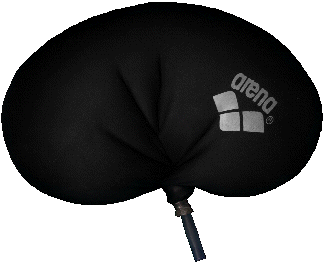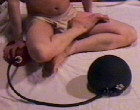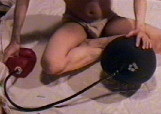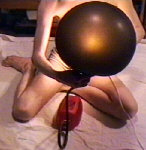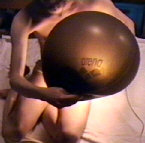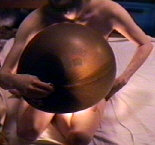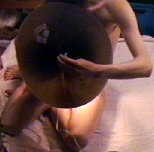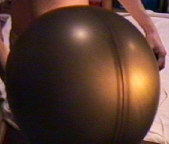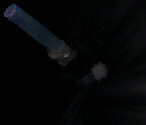Swimcap resonators
latex swimcaps
A great difference between Arena latex swimcap resonators and ordinary toy balloons is that these resonators have an astonishingly low hysteresis, i.e. unlike toy balloons, after deflation they return almost perfectly to their original size. (Despite it should be avoided to operate them unnecessary long in high operating ranges, because this is generally extreme stress for even the best sorts of latex and would eventually hurt it. Latex needs to be treated with high respect to make spiritual development possible.) Besides Arena, another very good latex swimcap brand for making resonators is BECO; they have a relatively low steepness and also a very nice smell (a little tomato- like?). In opposite to this, most Speedo latex swimcaps are rather badly suited for resonators, because they have an extremely high hysteresis (like ordinary toy balloons) and a strong, bad smell (containing ethylene?); very much like toy balloons they also have a high steepness and even in their 3rd range they still feel quite soft and seem to be extraordinary stretchable. But the only halfway interesting application for this sort is that in resonaKampaña they are capable to produce a very deep, soft and thunderish booming bass drum sound - very much like the one known from early acid house musics. Possibly there are also other Speedo latex variants, because I also found one printed Speedo swimcap sort which material has similarly good properties like Arena ones.
Beside smooth latex swimcaps (like seen above), also single layer latex swimcaps with embossed relief structure can be inflated as resonators. Such swimcaps usually have a thick, glued rubber rim, but usually this can easily be peeled of by hand to prevent difficulties when mounting the inlet pipe. As resonators they are particularly usable for resonaKampaña, because they can make interesting sounds already in low operating ranges. It is recommended not to operate such resonators higher than a medium 2nd range, due to their complex relief structure may be prone to get overloaded by drift instabilities. Also their material is typically less stretchable than smooth latex swimcaps. Double layer (bubble wrap style) rubber swimcaps (at least the kind
I found) are very badly suited for resonators and can not be recommended;
their synthetic rubber (neoprene??) is only little stretchable, tears quite
easily and (worst) emits a chemical antiprana
cocktail of chlorine and toxic nitro solvents, which makes them unusable
for meditation.
silicone swimcaps (warning
- they can be toxic!)
Compared with latex ones, silicone swimcaps are a little thicker and less stretchable (about 43cm longitudinal diameter in a low 3rd operating range) and feel very smooth (in no way sticky), but astonishingly they seem to have almost no (!) hysteresis, which might be a hint that they possibly can live very long in a 2nd operating range. (Like with latex, their steepness increases too when driven into their 3rd range (which can result in asymmetric deformations when overloaded this way), but undesired effects seem to be rather weak and progressing instabilities are not noticeable in lower operating range.) In low ranges the steepness of silicone generally seems to be higher than of latex, which makes such resonators in a 2nd range feel rather soft and gentle (somewhat skin- like?). Operated in low 2nd ranges vibration transmission of silicone resonators seems to be a little weaker than with average latex swimcaps (due to the combination of thicker membrane and higher steepness lowers their resonance frequency and increases damping), but they despite transmit vibrations well enough to work fine for meditation. Silicone rubber also does not degrade by exposure to sweat, fats and humidity, though all together these often prettily designed swimcaps could be well worth their money to create resonators from. For meditation resonators silicone swimcaps seemed to be the 2nd best choice I found straight after latex - unfortunately I later got very sick by their vapours - apparently the material of average silicone swimcap sorts is anything but medical grade silicone and is likely very toxic (at least the sorts I tried). At the beginning meditation with them worked fine - possibly higher and more complex spiritual functions like consciousness conduction (see here) worked worse than with latex. But all lower meditation functions (including vibration transmission and even resonaKampaña) seemed to work quite well with silicone, so I hoped I had found at least an almost perfect alternative for latex allergics, and the stretchability of this sweat proof elastomer would even have been fairly enough to build inflatable meditation suits from. Later I bought a multi- coloured Fashy silicone swimcap (in white with blue, pink and yellow areas) which emits a noticeable PVC- like plasticizer antiprana, though I discovered that also the smell of silicone is not always good, but at least at stretched membrane zones most of this chemical smell faded away quite quickly. During elastAyama I managed to carefully drive this pretty specimen up to a maximum longitudinal diameter of about 51cm in its 3rd range without damage. Like latex the material gets feelable tighter when driven to this limit, and also a tiny amount of hysteresis may have remained after such extreme load, but generally silicone appears to be a very good elastomer, so I wondered why this fat- proof rubber material besides for medical articles and electronic keypads is not more widely used for modern household objects today. Warning - never inhale from silicone swimcaps - toxic vapours!!Then I bought a BECO silicone swimcap (blue- purple marbled), which had a (not that pleasant) smell somewhat between vinegar, coffee and photo chemicals. In pranayama experiments I tried to pull it far down over my head (like I previously had done with thin disposable latex gloves), which worked fairly easy due to the very high steepness of the material and its wonderful feeling smoothness. But after I 2 times inflated it largely by nose or mouth this way and inhaled from it, I discovered that lots of unpleasant noise from my hands and tongue ran through my nervous system and that they slowly started feeling numb like under an anaesthetic. I am experienced in pranayama and I in no way had re-inhaled the exhaled air long enough to expect suffocation by the lack of oxygen, and by my neurological knowledge also an overdose of CO2 would rather result in sleepiness instead. Also the swimcap rim was neither tight enough nor located in a way that it could have squeezed off the brain's blood supply. Due to in a tantric experiment I also had carefully navigated along the border of a near- orgasmic state (as a self- test to verify certain concepts of the use of breathe control masks in the rubberist scene), I assumed that the combination of CO2 and strong muladhara chakra activity could have produced this bad side effect, because I had lost control and crashed down into a lousy orgasm at that time.Though later I again tried similar experiments with a violet marbled BECO silicone swimcap, which due to instabilities of a material fault on one of its sides inflated to an extremely thin, soft, large, transparent bubble that felt similar like entirely stretched polyethylene foil and that showed severe hysteresis after deflation. While I blew up this faulty cap over my head in a kind of elastAyama experiment, the bubble finally broke. Unlike latex, over- stretched silicone rubber does not tend to turn sticky but rather becomes slimy because it emits a weird kind of smeary silicone oil (or plasticizer?) chemical that tends to coat everything it touches with an invisible film which e.g. made the plastic nozzle of my air bellows fall off its cone fixture. (I had to wash the nozzle and fixture with soap to remove this grease.) When I tried to make an experimental resonator of the remaining piece using some cable ties, I discovered another unpleasant property of the material; cable ties very easily pinch holes through the thin membrane of silicone swimcaps, only their thicker rim can bear this pressure well. (Comparable thin latex is less prone to such perforations.) When overloaded, the silicone membrane also bursts much quieter that latex, which is a hint that it contracts slower than latex (because a loud bang only occurs when the material contracts with supersonic speed). Though the smeary substance likely acts as a plasticizer; remember: plasticized PVC also contracts very slowly, and its plasticizers (phthalates) are known to be very toxic. The same day I made from the blue- purple silicone swimcap a meditation mask by cutting breathe holes into it using a scissors (an office paper punch didn't work well). The soft and smooth silicone rubber could easily be stretched over the entire head and felt pleasant and comfortable. Unfortunately some hours after the end of the yoga session I felt again that lots of noise coming from hands and tongue was rumbling through my nervous system, and this time for more than a week my skin's nervous system stayed maladjusted in a way like when an armada of tiny, sharp- edged metal robots was crawling around under my skin, which interrupted my connection to cosmic consciousness in a cruel way and threatens my existence. 5(?) days later I pulled a brand new, washed, disposable latex glove over my head and performed pranayama to verify whether the maladjustment was really caused by silicone or if it just was a CO2 problem, but now even without a silicone swimcap I got these maladjustments. I am not sure if this was triggered by the CO2 or by the brand new glove's antiprana (seems to be mainly ammonia, but might contain traces of a silicone oil coating too), or only by this in combination with the likely carbon monoxide infested air of a coal stove heated room, or if I am now about to become allergized against everything (MCS = multiple chemical sensitivity). 2 days later (in a stove- free room) I tested again just to meditate and sleep next to the multi- coloured Fashy silicone swimcap resonator (without pulling anything over the head nor doing intense pranayama) - after only 2h I woke up and my entire tongue and hands were so numb like when a doctor would have given me a anaesthetic syringe. After deflating the resonator and putting it away it took at least 3h until the numbness started to disappear, and the feeling of spiky nano- robots is still there. Due to the spiky feeling noise mainly affects hands and tongue, those got both in direct contact with the smeary chemical, I assume that this substance (those vapours I likely also inhaled) is the cause of the problem and that I got an allergy against it by a direct poisoning. (On this site are some explanations about silicone oil poisoning.) I hope that the maladjustment will disappear again and that this isn't the way my karma punishes me for sufferance I may have caused (or because I have betrayed the only true magical material - namely latex - for something chemical???). It's such a pity when silicone rubber is toxic, because by its fat and
humidity resistance and the lack of stickiness it could have been a perfect
material to bring rubber meditation equipment and garments into mainstream.
I hope that non- toxic variants of it can also be produced for less than
the astronomic prices of medical implant silicone. (Some people may even
feel sensually particularly attracted by the gentle and smooth feeling
surface - why does nobody make inflatable cuddly toys for children from
such a material?!)
|
